Import Testing of Pharmaceutical Products Has Limited Safety Benefits and Can Add Risk to Patients
George Diebold/Getty Images
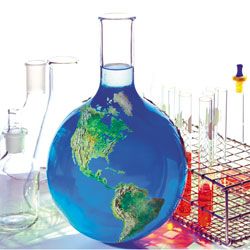
To help ensure drug product quality and safety, health authorities in many countries have implemented, or are considering implementing, quality control (QC) testing requirements for pharmaceuticals, biological/biotechnology, and/or vaccine products entering their countries-also referred to as import testing. A survey was conducted within the International Federation of Pharmaceutical Manufacturers & Associations (IFPMA) to analyze data on import testing, other categories of re-testing (e.g., post-marketing surveillance), and applied waiver types. The findings suggest that import testing does not add significant quality or safety benefits to patients, provided that the products are uninterruptedly controlled according to the globally harmonized manufacturing, distribution, and storage standards (GMP, GDP, GSP). In fact, it was observed that import testing could potentially increase risks to the patient by causing delay in the supply chain and other complexities.
Historically, re-testing requirements may have been necessary to prevent the distribution of unsafe or non-conforming drug product; however, laws, regulations, and regulatory oversight have changed significantly. Today, pharmaceutical, vaccine, and the biotechnology industries have developed and implemented robust quality systems and control of the supply chain to ensure the identity, safety, purity, and potency of its drug products throughout their manufacture and international distribution channels. The requirement of import testing is, therefore, regarded to be redundant (1, 2). This perspective has been evidenced by data presented herein, analyzing quantitative figures on import testing collected from multinational pharmaceutical companies.
Survey results
The presented data were received from six multinational pharmaceutical companies-Amgen, AstraZeneca, Bayer, F. Hoffmann-La Roche, Johnson & Johnson, and Pfizer-associated with IFPMA, unless otherwise specified. In total, 184 data sets of information on 149 countries, collected from September to November 2014, were analyzed. Data were collected from the six companies on:
- re-testing requirements
- number of re-tests per year
- number of out-of-specification (OOS) investigations and batch rejections
- the costs associated with the testing and related costs, such as warehousing or blocked capital.
Categories of re-testing in the country of destination. Apart from re-testing associated with the import of pharmaceutical products, other testing categories were reported. Re-testing may be performed by companies themselves, contractors, and/or governmental laboratories in each country. The different categories of local re-testing reported and their impact are described subsequently:
Import testing
- QC testing (full or partial local re-testing against approved specifications) for medicines as part of the importation process.
- Performed in governmental laboratories or under the responsibility of the manufacturers/importers.
- Causes prolonged storage of the goods in warehouse upon import.
- Increases complexity in chain of custody/supply chain.
- Can lead to delayed supply of medicine to the patient or product stock-out.
- or small markets, the amount of required samples can be a significant portion of the total importation.
Registration testing(a) Testing in conjunction with initial registration
- Regarded as part of the initial “validation” by law in some countries.
- Often implemented to establish innovative test methods/techniques in a country.
- Can result in a significant delay to availability of new innovative medicines to patients.
(b) Testing in conjunction with post-approval changes and/or license renewal
- Results in administrative and financial (high sample costs) burdens.
- Does not usually impact supply during the commercial phase.
Surveillance testing
- Represents an independent control of medicines on the market.
- Opportunity to detect counterfeit/falsified medicine (3) or unauthorized imports. These data may also help to understand these threats and to define appropriate measures.
- No delay in access of medicines to patients.
- An accepted practice to monitor the quality of marketed medicines.
Re-testing requirements by country. Data on requirements from 129 countries (the European Union market was counted as one country) were collected and assessed. Table I provides an overview of the countries with such requirements by categorizing them in terms of the extent of testing. Table II outlines the testing requirements by country. The countries are subsumed by regions: Asia Pacific, Eastern Europe, Western Europe, Commonwealth of Independent States (CIS), Middle East, Africa, North America, Central America and the Caribbean (CAC), and South America.
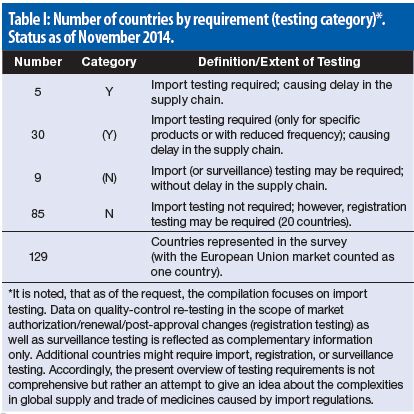
Table II. Testing requirements by country. Status as of November 2014.
Who performs the testing: Governmental laboratory (Gov), Companies laboratory (Comp), Company could use certified laboratory (Gov/Comp).
Requested testing for product categories: Active Pharmaceutical Ingredients (API), API biological/biotech (API/B), Drug Product (DP), Drug Product Sterile (DP/S), Combination Product/Medical Device (Comb), Vaccine (Vac), Others (O).
EDQM is European Directorate for the Quality of Medicines & HealthCare; EEA is European Economic Area; EFTA is European Free Trade Association; MOU is Memorandum of Understanding; MRA is Mutual Recognition Agreement; N/A is not applicable; N/I is no information available; OMCL is Official Medicines Control Laboratories; Reg. is registration testing at governmental laboratories; Surv. is surveillance testing at governmental laboratories.

(
)
Multiplication of tests along the global supply chain. Multinational manufacturers manage global product supply chains. One drug product batch may be dispatched to several countries (i.e., batch splitting) after country-/region-specific packaging. Accordingly, the same batch may undergo several re-tests. Table III provides examples for a recombinant interferon and a chemical product.
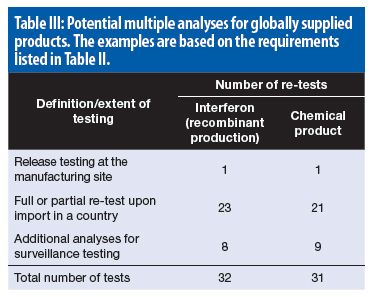
A special situation exists in Chile, where two local sets of re-tests are required for the import of biological products (4). In addition to the partial re-test under the responsibility of the importer/manufacturer, the products are subject to testing at governmental laboratories, referred to as “series control.”
Delay to supply. The local re-testing process takes significant time. Information from 29 operations in 18 different countries was received. The average supply-chain delay is summarized in Figure 1 and ranges from two to 19 weeks. The maximum absolute delay was reported as 22 weeks (such as biologics testing in China). It is noted that re-testing can be further prolonged in case of OOS investigations or other delays (e.g., if required materials/reagents are temporarily not available due to import procedures).
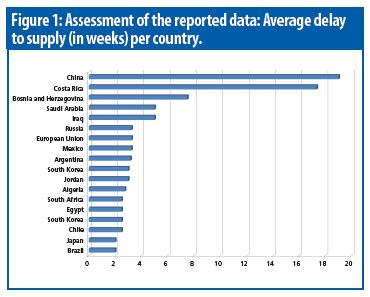
Quality-control figures. The survey collected annual data on the number of re-tests (full or partial), OOS investigations, and batch rejections. Six companies reported a total of 18,616 re-tests performed per year. Of these, one re-test resulted in a batch rejection. The overall figures are shown in Table IV.
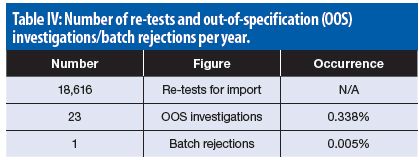
Associated resources for testing. The following costs (per year) were queried in the survey: (a) costs of local QC analytics (e.g., for testing, samples, contract laboratories) and (b) loss by blocked capital due to longer storage duration of the inventory (e.g., warehoused at customs). The responses were aggregated in subsets according to the reported cost figures, as follows:
- Subset 1: Nine in-country operations reported both figures (a + b). Countries reported are Argentina (1 operation), China (1 operation), EU (3 operations), Israel (1 operation), Mexico (2 operations), and South Korea (1 operation). The resulting annual costs associated with import testing accumulate to €57,716,457, calculated from costs of local QC analytics (€20,044,198) and blocked capital (€37,672,259).
- Subset 2: Thirteen in-country operations reported just one of the requested figures (a or b). The total reported annual costs from all 22 in-country operations (including Subset 1) add up to €88,305,744.
- Subset 3: A second survey within the European Federation of Pharmaceutical Industries and Associations (EFPIA), conducted January to February 2015, was performed focusing on material subjected to import testing in the EU after import from the United States. Fifteen multinational pharmaceutical companies reported 8495 product batches for 2014 (5). Considering €2950 as the average cost per re-test (see below), the costs add up to €25,060,250.
Reported costs per re-test. Costs per re-test were deduced from the data sets, where in-country operations reported the number of re-tests and costs (at least the costs of local QC analytics). Twenty two in-country operations reported 17,164 re-tests and an associated costs of €50,633,485. The resulting average costs per re-test are €2950.
Hidden costs. Companies provided details of additional resources required for local re-testing even if the testing is not performed under their responsibility. To support re-testing at the government laboratories, costs arise, for example for:
- analytical method implementation (including training activities)
- equipment (e.g., chromatographic columns) and devices (e.g., method-specific apparatus)
- critical reagents and reference standards (including qualification)
- importation and customs requirements for these materials.
These additional costs are typically not monitored and may not be reflected in the reported figures accordingly.
Types of waivers implemented. Global re-testing requirements were presented in Table II. Responding companies also reported that local regulations permit waivers from local re-testing, where different approaches were identified:
Legal
- formation of an union (e.g., EU member states)
- mutual recognition agreement (MRA) (e.g., EU-Switzerland, Australia-Canada)
- Agreements on Conformity Assessment and Acceptance of Industrial Products (ACAA), which is a specific type of MRA based on the alignment of the legislative system and infrastructure of the country concerned with those of the EU (e.g., EU-Israel)
Regulatory
- for specific product categories (e.g., chemical products, Egypt or orphan drugs/indications, South Korea)
- for products filed under a simplified procedure (e.g., Collaboration Agreement of Drug Regulatory Authorities in European Union Associated Countries [CADREAC] in Turkey)
Compliance
- countries with comparable control of manufacturing/transport (e.g., Switzerland)
- transport validation: temperature data available from shipment (e.g., Brazil)
- compliance status evaluated through certification (inspection) of the manufacturing, analytical, and/or packaging site (e.g., India, Mexico, most CIS states)
Practical
- testing cannot be performed locally (e.g., South Africa)
- import of small quantities for selected patients or groups of patients (e.g., South Africa).
DiscussionImport testing adds limited quality or safety benefits to patients. Companies reported 18,616 re-tests were conducted per year, which resulted in one batch rejection. This result equates to a batch rejection rate of 0.005%. This low batch rejection rate indicates that firstly, there is no significant difference between the results of the original certificate of analysis (CoA) results (manufacturing site) and the import testing (local re-testing); and secondly, distribution following good distribution practices (GDP) is under control. Accordingly, import testing does not seem to add verifiable value for supply-chain security and patient safety.
Delay to market increases risk for drug shortage. The average delay in releasing the drug to the market caused by the local re-testing is approximately four weeks and varies from two to 19 weeks. It is not always predictable when the final release to the market can occur. OOS investigations or other testing issues (e.g., if needed materials/reagents are temporarily not available due to import procedures) may result in delayed release of product into distribution. Accordingly, import testing may lead to interrupted supply of important medicines to patients.
Remaining shelf-life period can limit product availability. The maximum reported absolute delay caused by import testing was 22 weeks or approximately five months (China). According to the Chinese drug importation regulations (6), the minimum remaining shelf-life (RSL) should be at least 12 months. For drugs with a shelf-life less than 12 months, the RSL should be at least six months. This example indicates that import testing can significantly reduce the RSL of a medicine, and consequently increase the risk of interruptions in the supply of the medicine.
Increased supply chain complexity does not benefit patients. At the time of importation, the materials often have to be stored under quarantine in customs (bonded) warehouses for a certain period, which may be prolonged due to import testing. These warehouses are to a certain extent not under the control of the importer/manufacturer and, therefore, may not be qualified according to the standards applied and enforced in the pharmaceutical industry. Accordingly, the storage in these warehouses may increase the risk for temperature deviations.
Moreover, a less stringent chain of custody for test samples may increase the risk for samples to be lost or diverted, and material to be contaminated/soiled/violated as security/tamper-evident seals need to be broken for these operations. These risks are reduced when robust GDPs are not interrupted (7).
Import testing vs. surveillance testing. The test samples are generally taken directly after customs clearance upon import and straight from the imported batches. After the batch is produced under good manufacturing practice (GMP) at the manufacturing site, its integrity is maintained through adherence to GDP and good storage practices (GSP). Considering transport controls and possible monitoring data, it can be expected that re-testing results would not be significantly different from the manufacturing site’s CoA. The reported rejection rate of one in >18,000 batches supports this conclusion and also shows no evidence that import testing detects counterfeited products (also see Table IV). Accordingly, testing upon import does not add value, if all relevant good practice quality (GxP) guidelines and regulations are applied. Furthermore, conducting re-testing at the point of entry into a country does not reflect additional, or greater, risk related to local distribution channels.
Although not comprehensive, post-marketing surveillance testing is much better suited to monitor independent control of medicines on the market nearer to the direct supply to the patient. Samples taken from wholesalers, pharmacies, or hospitals could also provide the opportunity to verify compliance of the medicinal product with approved specifications, detect counterfeits (3), unauthorized imports, or manipulations reflecting the entire supply chain. In addition, such data may help to understand these threats and to define appropriate measures for their mitigation. Serialization requirements (8), currently implemented across many the supply chains, make even surveillance testing obsolete for the detection of counterfeits. Furthermore, this risk-based approach would not cause any delay in access of medicines to patients.
Reported costs may underestimate actual costs. Significant costs are associated with import testing. Because of the limitations of the survey (data from only six companies); however, it is believed that the actual expenditure by the industry is much greater than that reported due to the difficulty in fully accounting for the impact of import testing. In many cases, these costs will feed through into the costs of the medicines and consequently impact costs to the public healthcare systems and patients.
Recognizing the high costs connected to the product import, some countries established waivers from import testing for orphan drugs/indications (e.g., South Korea) and high price/low turnover products (e.g., Chile, Ukraine). For small markets, the number of samples required can be a significant portion of the total imported quantity into the market.
Several countries have implemented waivers from local re-testing. In total, 13 countries reported waiver procedures (see Table II). The different types of waivers have been described in this article. Waiver procedures provide the opportunity for the legislators to grant exemptions from secondary testing, where the importing country’s health authority has confidence that the product is safe, efficacious, and complies with registered specifications.
Elimination of import testing is justified based on (1):
- Evidence that the product manufacturing, testing, and storage/distribution systems are well controlled and validated.
- An effective quality system is in place to assure compliance.
- Oversight by regular audits and inspections performed by regulatory authorities (9, 10).
Even if import testing is required by laws/regulations, waiver processes may be defined in the corresponding guidelines without violating overarching laws. If any legal possibility for waivers is lacking, it is suggested that the legislative requirements should be amended to enable exemptions from import testing under well-defined conditions.
Increasing international convergence
Modern product development ensures comprehensive process understanding and well-characterized products. Nowadays, pharmaceutical manufacturing is highly regulated and controlled. The modern pharmaceutical industry together with regulatory authorities and global organizations (e.g., PIC/S, WHO, ICH, ASEAN, APEC) have established appropriate controls of the manufacturing process through substantially advanced process understanding, in-process controls, validation of the manufacturing process and transportation as well as release testing complying with international globally recognized GxP standards: GMPs (11–14), GDPs (7, 15–17), and GSPs (18).
Recognizing the consequence of the successive controls across the entire supply chain, several global health authorities, including ANVISA in Brazil (19), the United States Food and Drug Administration (20, 21), and the Ministry of Health of Ukraine (22), have eliminated import testing for certain biological products. Likewise, China (SFDA) has eliminated secondary testing for chemical products (e.g., clinical-trial materials).
The increasing international convergence on this topic is also reflected in statements of the World Trade Organization (WTO) and the EU. The WTO regards the “burdensome practices for certification and testing of products” as non-tariff barriers “which adversely affect the distribution trade.” Accordingly, a country will benefit from “the removal of barriers caused by differences in national product regulations and the elimination of border controls” by enhanced international trade (“internationalization of distribution”) (23). The EU stated that one of the goals of the EU–US Transatlantic Trade and Investment Partnership is to “reduce redundant and burdensome testing and certification requirements” (2).
Conclusion
With a reported batch rejection rate of 0.005%, it was observed that import testing does not add additional quality or safety benefits to patients if appropriate controls can be demonstrated and provided products are controlled according to GxP standards through the entire supply chain. In fact, import testing introduces potential for increased risks to the patient associated with supply chain delay and complexity.
This study reports approximately four weeks delay to supply (22 weeks maximum reported delay) and potential significant loss of product shelf life. Patient risk is potentially increased due to less controlled storage conditions and less stringent chain of custody.
Import testing may lead to additional complexity in the overall supply chain, repeated tests along the global supply chain (i.e., a drug product batch may be analyzed up to 32 times), increased local inventory/warehouse capacity, and considerable increase in costs (on average, approximately €3000 per batch imported). These costs triggered waiver processes in some countries for orphan drugs/indications and high price/low turnover products, respectively.
For these reasons, it is recommended the regulators establish exemptions from import testing under well-defined conditions and that timely waiver processes are employed where appropriate manufacturing and distribution controls have been demonstrated. Where the legal framework does not allow for waivers, it is suggested that the legislative requirements should be amended to enable exemptions from import testing.
It is acknowledged that import testing could offer value, for example, if the abovementioned conditions are not met. In the case of the single batch rejection reported in this survey, a discrepancy in the upstream processing of the product (e.g., transportation) could be the cause and secondary testing may have prevented an inefficacious or harmful medicine reaching patients. However, the 18,615 released batches indicate that the controls, discussed in this publication, are comprehensive and highly effective. Moreover, these control processes are subject to continual improvement as part of a modern pharmaceutical quality system (24).
Post-marketing surveillance testing offers the possibility to execute risk-based quality checks and is much better suited to detect counterfeits or unauthorized imports as it includes local distribution channels.
Acknowledgements
The authors thank Ivana R. Antonacci (Merck & Co., Inc., Kenilworth, New Jersey, USA) and Angela McGillivary (Biogen Idec Ltd, Berkshire, United Kingdom) for constructive discussions.
References
1. IFPMA, “Appropriate Control Strategies Eliminate the Need for Redundant Testing of Pharmaceutical Products,” www.ifpma.org/uploads/media/IFPMA_Position_Paper_on_Redundant_Testing_05.pdf, accessed 6 July 2015.
2. European Commission, “Technical Barriers to Trade,” Initial EU TTIP Position Paper, 16 July 2013.
3. K. Outterson and R. Smith, Alb. L.J. Sci. & Tech. 16, 526–43 (2006).
4. Ministry of Health of Chile, “Reglamento del sistema nacional de control de productos farmacéuticos de uso humano (Regulation of the national system of control of pharmaceutical products for human use),” DS 03/10, 2010.
5. S.K. Roenninger and J.H.O. Garbe, “Import Testing: Limitation of Patient Access to Medicines,” in publication.
6. China State Food and Drug Administration (SFDA), “Medical product import regulation. Administration of import drug,” SFDA Order No. 4, 2004.
7. WHO, “Good distribution practices for pharmaceutical products,” WHO Technical Report Series, No.957 (Annex 5) 2010 (Geneva).
8. EC Directive 2011/62/EU of the European Parliament and of the Council of 8 June 2011 amending Directive 2001/83/EC on the Community code relating to medicinal products for human use, as regards the prevention of the entry into the legal supply chain of falsified medicinal products, Official Journal of the European Union, L 174/74, 1/7/2011, 2011.
9. IFPMA, “Global GMP Inspection Landscape-Industry Point of View and the Way Forward,” www.ifpma.org/fileadmin/content/Quality/Inspections/Foreign inspections IFPMA presentation 2010.pdf, accessed 6 July 2015.
10. EFPIA, “Enhanced Good Manufacturing and Good Distribution Practices (GMP/GDP) Inspection Efficiency,” www.efpia.eu/uploads/documents/EFPIA_Enhanced Inspection Practice - Final_v8a_19May2014.pdf, accessed 6 July 2015.
11. WHO, “Good Manufacturing Practices for Pharmaceutical Products: Main Principles,” Technical Report Series, No. 961 (Annex 3) 2011.
12. EC Guidelines EudraLex, Vol. 4, Good Manufacturing Practice Medicinal Products for Human and Veterinary Use (Brussels, 2010).
13. Code of Federal Regulations, Title 21, Current Good Manufacturing Practice for Finished Pharmaceuticals (Government printing Office, Washington, DC) Part 211.
14. PIC/S, “Guide to Good Manufacturing Practice for Medical Products,” PE 009-11, 2014.
15. PDA, “Guidance for Good Distribution Practices (GDPs) for the Pharmaceutical Supply Chain,” Technical Report No. 52, 2011.
16. EC Guidelines 2013/C 343/01, Good Distribution Practice of medicinal products for human use (Brussels, 2013).
17. PIC/S, “Guide to Good Distribution Practice for Medical Products,” PE 011-1, 2014.
18. WHO, “Guide to Good Storage Practices for Pharmaceuticals,” Technical Report Series, No. 908 (Annex 9) 2003.
19. ANVISA, “Quality Assurance Requirements for Non-Biological Imported Products,” Resolution RDC No. 10/2011 (2011).
20. FDA, “Reinventing Regulation of Drugs Made from Biotechnology,” Press Release 9 Nov. 1995.
21. FDA, “Interim Definition and Elimination of Lot-by-Lot Release For Well-Characterized Therapeutic Recombinant DNA-Derived and Monoclonal Antibody Biotechnology Products,” Fed. Reg. 60 (236), 63048-63049 (8 Dec. 1995).
22. Ministry of Health of Ukraine, “About approval of the Procedure of control of compliance of the immunobiological preparations applied in hospital practice, to requirements of the state and international standards,” Command No. 698 (1 Oct. 2014).
23. World Trade Organization (WTO), “Distribution Services,” Note S/C/W/37, 10 June 1998.
24. ICH, Q10 Pharmaceutical Quality System, Step 4 version (2008).
Joerg H.O. Garbe is global quality manager, In-Country Testing, F. Hoffmann-La Roche Ltd., Pharma Global Technical Operations, Basel, Switzerland.
Karl Ennis is in-country analytical testing project leader, Global Analytical Development, GlaxoSmithKline, Hertfordshire, UK.
Guido M. Furer is commercial QA manager, LA Region, AbbVie S.A., Buenos Aires, Argentina;.
Maria G. Jacobs is director, Quality and Regulatory Policy, Pfizer Inc., New York, US.
Stephan K. Roenninger is head of external affairs Europe, Amgen (Europe) GmbH, Zug, Switzerland.
Article DetailsAPI, Excipients & Manufacturing Supplement to Pharmaceutical Technology
Vol. 39, No. 9
Pages: s18–s26
Citation: When referring to this article, please cite it as J. Garbe et al, “Import Testing of Pharmaceutical Products Has Limited Safety Benefits and Can Add Risk to Patients,” Pharmaceutical Technology API, Excipients & Manufacturing Supplement39 (9) s18–s26 (2015).
